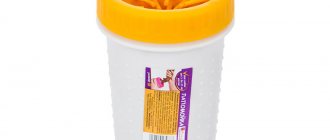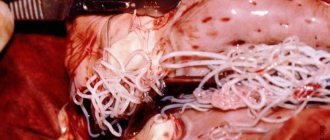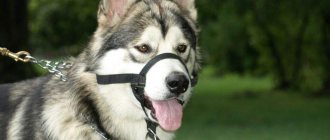| ATTENTION! The article contains photographs of the operation and is not suitable for the impressionable. |
Cryptorchidism is a pathological condition characterized by failure of one or both testes to descend into the scrotum.
At the stage of embryonic development of puppies, the testes are located in the region of the kidneys and are connected to the scrotum by a special ligament - Gubernaculum testis. As the dog grows, this ligament shortens and pulls the testes through the abdominal cavity and inguinal canal into the scrotum. The descent of the testes into the scrotum in males occurs on the 10th – 14th day after birth (in some breeds this may occur later). Closure of the inguinal canal occurs, most often, at the age of 6 months, therefore, prolapse of the testes at a later age in male dogs is unlikely.
The unnatural location of the testes is accompanied by a decrease in their reproductive function. It is known that normal spermatogenesis in males is carried out by the testis in the scrotum at a certain temperature (2 - 4 ° C below body temperature), therefore the testis located outside the scrotum cannot function normally. As a result, cryptorchidism in dogs leads to a decrease or complete extinction of spermatogenesis and a high (14 times higher) risk of its neoplastic (tumor) degeneration. The most common testicular tumors in dogs are sertoliomas, semenomas and leydigomas. Some of them are hormonally active and produce estrogens, which adversely affects the health of the male dog and can lead to cystic prostatitis, anal gland hyperplasia and suppression of bone marrow activity. Also, an undescended testis can often be subject to various mechanical damage, including torsion of the spermatic cord, accompanied by the symptom of an “acute abdomen.”
What is cryptorchidism in dogs and how dangerous is it?
The first signs of cryptorchidism appear in puppies. At birth, their testes, or testicles, are located in the abdomen. They are connected to the scrotum by Gunther's ligament, which takes the main part in their subsequent descent.
By 6 months, it shortens and pulls the testes right into the scrotum. Under the influence of certain factors, one or both testicles may not descend even by this age. In this case, the animal experiences the following complications:
- Deterioration or complete loss of reproductive function.
The temperature inside the body reduces sperm activity. Because of this, a sick pet cannot conceive offspring.
- Tumor formation.
Overheating affects not only sperm production, but also the degeneration of healthy cells. Without timely help, the dog may die due to leydigoma, sertolioma or seminoma.
- Hormonal disbalance.
Instead of male hormones (testosterones), the body begins to actively produce female hormones (estrogens). This leads to the development of cystic prostatitis, anal gland hyperplasia and bone marrow pathologies.
- Inversion of the spermatic cord.
It is accompanied by acute pain, vomiting, nausea, bowel dysfunction, fever and chills.
The anomaly in question is a genetic disease, that is, it is inherited. For this reason, cryptorchid dogs must be excluded from further breeding.
Possible future consequences
A male dog with unilateral cryptorchidism can live his entire life quite normally, not get sick, and even have offspring. Of course, this applies only to non-pedigreed animals, because purebred animals with such a diagnosis are excluded from breeding in order not to pass on the pathology by inheritance. And one of his descendants will definitely have it, so there is no need to risk it.
Cryptorchidism can threaten the dog itself with health problems - the formation of a tumor on the testis already at a fairly young age. Another danger is that if the testis is located in the abdominal cavity, then, although rarely, the spermatic cord can become twisted, which causes severe pain and other complications.
The main symptom is undescended testicle
The danger of the disease lies in the absence of pain and discomfort. Because of this, owners learn about the violation only during a routine examination by a veterinarian or when complications develop.
Despite this, a cryptorchid puppy can be recognized by its appearance. If by 6 months his scrotum is still empty, sign up for treatment.
In rare cases, the disease is accompanied by redness and swelling of the external genitalia, as well as abdominal pain. Hair may fall out in the scrotum area, and the skin adjacent to it may change color or become darker.
Forecast
Usually the disease is cured quickly and no complications arise. After three weeks, the animal recovers and can return to its usual routine.
In some cases, complications are possible, but they occur rarely and are associated with the characteristics of the body or disturbances during the procedures (for example, contamination of the suture).
It is important to monitor your pet not only in connection with sterilization, but also at the slightest suspicion of a disease. It can affect more than one offspring, so why not just monitor the pet and provide the necessary assistance in a timely manner. With constant monitoring and care of the dog, no problems will arise.
Causes of cryptorchidism in puppies
The disease develops at the embryonic stage or shortly after birth. In the first case, the reason lies in:
- a gene passed on from the father;
- malnutrition of the mother, who did not receive the required amount of vitamins A and B9;
- anatomical features (large testis or underdeveloped scrotum, short spermatic cord, weak ligaments or too narrow inguinal canal).
In all other cases, infections of various etiologies, injuries and hormonal imbalances are to blame for the anomaly. As a result of their influence, the process of descent slows down or stops.
Purebred dogs get sick more often than mixed breeds. The risk group includes small and short-faced breeds: dwarf poodles and dachshunds, Yorkies, Chihuahuas, Spitz, Pekingese, bulldogs, boxers.
Reviews
Irina, 37 years old, Krasnodar
“I have a Yorkie, unilateral cryptorchid. We went to the doctor when it was still 4 months, the doctor said to wait until 6. If this happens, he will refer me for surgery and we will suture the testicle to the scrotum. As agreed, we showed our Caesar at 6 months, and the veterinarian advised us to wait another two months or, even better, up to a year. We waited and hoped that it would go down on its own. Alas. As a result, we were prescribed to inject Gonadotropin and repeat it in the future (after 6 weeks). The canals can still be stimulated and the testicle will come out. We are waiting for the results.”
Olga, 29 years old, Moscow
“My pug has been suffering from cryptorchidism for 3 years now and his testicle can’t even be felt. The veterinarian advises castration, but so far they have refused. The dog feels good, no complaints. Once every six months we undergo an ultrasound and examine him to catch the tumor. I think we’ll take you to surgery when you’re 5 years old.”
Types of pathology
Pathology is divided into several types. The classification is based on the time of development of the anomaly, the number and location of undescended testes, as well as possible ways to solve the problem.
Congenital or acquired
The main reason for the occurrence of a congenital appearance is poor heredity. The acquired form develops due to mechanical injuries, disturbances in the endocrine system and infection with fungi, bacteria or viruses.
Monolateral and bilateral
Monolateral, or one-sided, cryptorchidism in dogs is more common than bilateral, or two-sided. It rarely leads to infertility, since one of the testicles does descend. Sexual desire is also preserved.
With the second type the situation is reversed. Due to the stable heating of both testes, the dog loses its reproductive function and does not show interest in females.
True, false, risen
The true form is associated with anatomical abnormalities and can only be eliminated surgically. In contrast, the false one is notable for the free movement of organs between the abdominal cavity and the scrotum. After the provoking factor is eliminated, they return to their place, so surgery is not provided here.
The raised view is more unique. It occurs when the growth of the spermatic cord slows down, as a result of which the descended testicle rises back. It cannot migrate back without the help of a surgeon, so here, as with its true form, it cannot be done without surgery.
By location
The easiest way to diagnose is palpation, that is, palpation. According to the degree of palpability, pathology is divided into 2 types:
- Palpable.
Found at the top of the scrotum, on the inner thigh, or in another unusual location that can be felt.
- Non-palpable.
They can only be detected using special equipment. This is due to the size being too small, atrophy or an inconvenient location for palpation (abdominal cavity, inguinal canal). Also included here is agenesis - the congenital absence of both organs.
If you notice alarming symptoms, notice a discrepancy during examination, or confirm it manually, make an appointment with a veterinarian. After determining the type and cause of the disease, he will be able to choose an effective treatment for your pet.
Progress of the operation
Let us consider the progress of orchiectomy in a specific case. The patient is a male, 7 years old, mixed breed. The left testis is cryptoroid - located intra-abdominally in the hypogastrium. A diagnosis was made of true unilateral cryptorchidism with intra-abdominal localization of the left testis. First, before the operation, premedication is performed and then the animal is put under anesthesia.
The first stage - preparation of the surgical field is carried out taking into account generally accepted rules of asepsis.
Rice. 1. Preparation of the surgical field.
The next stage is surgical access. Surgical access is carried out layer by layer, above the location of the testis. The dissected vessels are coagulated.
Rice. 2. Surgical access.
Rice. 3. Surgical access, coagulation of blood vessels.
Rice. 4. Opening of the abdominal cavity.
The next step is to remove the left (cryptorchoid) testis. As you can see, it is significantly enlarged, which indicates its neoplastic degeneration.
Rice. 5. Extraction of the cryptorchoid testis.
Then the testicular vein, artery and spermatic cord are ligated and dissected. The testis is removed.
Next, the wound is sutured in layers.
Rice. 6. Layer-by-layer suturing of the wound.
The last step is to remove the normal testis. This happens as during normal castration of a male dog.
Rice. 7. Surgical access to the right (healthy) testis.
Rice. 8. View of the right testis.
Rice. 9. The vessels and spermatic cord are ligated/coagulated and dissected.
Rice. 10. The testis is removed. The wound is sutured.
Rice. 11. View of the patient immediately after surgery.
What studies will confirm the pathology?
When diagnosing cryptorchidism in dogs, it is necessary to collect a detailed history, conduct a visual examination and palpation. The information obtained helps in determining the location of the unemergent testes and the truth of the disease. To do this, the veterinarian probes the entire scrotum, inguinal canal and adjacent areas, and if displaced organs are found, he tries to set them in the right place.
Taking blood for general and biochemical tests for this disease is not the main study. It is performed when infection and other conditions affecting the basic parameters of the hematopoietic system are suspected.
The main role in making a diagnosis is given to the following studies:
- Ultrasound.
Used to find non-palpable species. The results obtained are not always accurate, since they are affected by excessive intestinal gas contamination and poor quality of the apparatus.
- Laparoscopy.
The most accurate method for determining the position of undescended organs, which involves minimally invasive insertion of a laparoscope into the pelvic area. Does not require a long postoperative recovery period.
- Test with the hormonal drug Gonadotropin.
The testosterone level is measured for the four-legged patient and the drug is administered. An hour after the injection, the level of male hormone is checked again. If it turns out to be higher than the first time, the diagnosis is confirmed.
Based on the results obtained, it becomes clear whether it is worth resorting to surgery or whether conservative therapy is sufficient to eliminate the problem. When making a decision, the doctor takes into account the cause of the pathology and its type.
Prevention
In most cases, cryptorchidism in dogs is a hereditary pathology, the occurrence of which is almost impossible to influence. The only means of prevention is a balanced and nutritious diet for the pregnant bitch, especially at the end of the period of gestation. In addition, the animal should only be paired with healthy males whose ancestors did not suffer from a similar problem.
As for acquired cryptorchidism, associated with injuries and infections, measures to prevent it include keeping the puppy in a warm and dry room, mandatory walks, a well-chosen diet, and timely vaccinations.
Treatment of cryptorchidism in dogs
The main and most effective method of treating pathology is castration. It is suitable in absolutely all cases, since otherwise the dog can pass the anomaly to its offspring or get cancer.
Does drug therapy produce results?
Drug therapy is effective in puppies under 6 months of age whose inguinal canal has not yet closed. It is also important that the pathology is palpable, and the reason for its appearance is a hormonal imbalance.
With this method of treatment, the four-legged patient is prescribed hormonal medications and massage courses. They stimulate the movement of organs in the right direction, promoting their prolapse.
Surgical prolapse of the testis
This operation is called orchiopexy. Under general anesthesia, the dog's peritoneum is cut and the testicles are lowered into the scrotum. After surgery, sperm quality improves in 30% of animals.
Despite this, the possible consequences should be understood. It is prohibited to breed a pet with this diagnosis, which is why many veterinarians refuse to perform orchiopexy.
The only convincing reason for operational omission is regular participation in exhibitions. Through surgery, you can achieve cosmetic improvements in appearance, which is very important for obtaining high grades.
Castration
Castration, or orchiectomy, involves the total removal of the reproductive organs. Depending on the location, the operation can be cavitary or non-cavitary.
What to pay attention to after anesthesia
Normally, the dog recovers from anesthesia calmly. Breathing is smooth, mucous membranes may be pale pink, but without unnecessary discharge or anxiety. Defecation occurs 1–2 days after surgery, thirst remains at the usual level. However, you should immediately consult a doctor if you notice one or more of the following symptoms:
- Body temperature exceeds 39.0 degrees Celsius.
- Weak intermittent breathing, wheezing in the sternum.
- Vomiting more than 2 times a day.
- Weak pulse.
- No signs of normalization more than 6 hours after anesthesia (the dog does not move, does not open its eyes).
The prognosis for surgical treatment of cryptorchidism is positive. After 2-3 months, the dog can swim in ponds and live a normal life.
Preoperative and postoperative care
To select a safe dose of anesthesia, a four-legged patient needs to undergo blood tests and have a cardiogram. During the postoperative period, the body's defenses are reduced, so before surgery, care should be taken for vaccination (20-30 days before) and antiparasitic treatment (10-14 days before).
You can wash the entire animal no later than one day before surgery. Water removes the protective layer, increasing the risk of infection in postoperative wounds.
You should also go on a fasting diet (12 hours before) and give up water (6 hours before). Otherwise, undigested food and water can cause vomiting, which can lead to aspiration pneumonia.
After waking up from anesthesia, the dog is returned to its owner. During the rehabilitation period you should:
- Take care to create a warm and comfortable place, protected from noise and other irritants.
- Strictly follow all doctor's recommendations for suture treatment.
- Avoid swimming before removing the suture material to avoid it getting wet and causing the wound to fester.
- Buy an Elizabethan collar or blanket that prevents wounds from licking.
- Avoid active games, long walks and contact with other animals.
If frequent vomiting, high fever, suspicious swelling, suppuration and other complications occur, you should consult a veterinarian. If the dog’s health is stable, then you should come for an examination only 2 weeks after the operation.
Preventive measures
Preventive measures to prevent a dangerous genetic disease are:
- purchasing a puppy from a responsible breeder who monitors the health of the dogs before mating;
- caring for a pregnant bitch: balanced nutrition, limiting contact with other animals, especially untested ones; taking medications only after consultation with a veterinarian and assessing the risk to the offspring;
- caring for puppies with a balanced diet, eliminating stress.
If there are any deviations in the pet’s health, you should visit a veterinary clinic specialist for a thorough examination of the pet and discuss all possible ways to treat the animal with prognoses for a favorable outcome of therapy or surgery.
Only the owner’s love and attention to the pet will help him overcome the illness and subsequently delight the owner with activity and cheerfulness.
Source: www.belanta.vet











